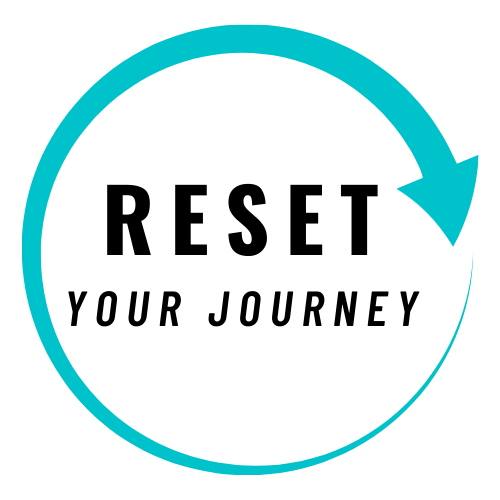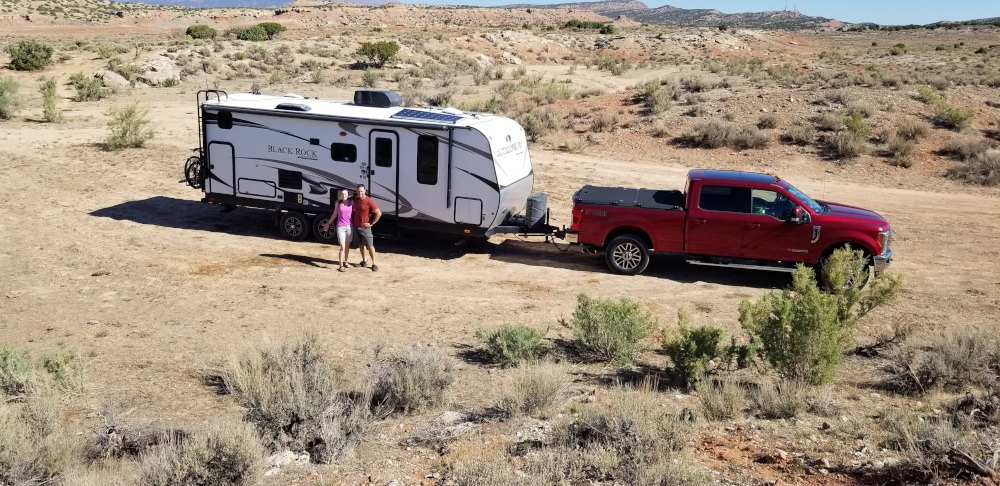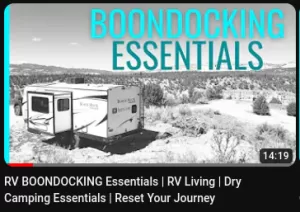Last Updated on 07/04/2024 by Glynn Willard
Important Steps For An RV On Your Travel Day
There’s more to your RV moving day than just a checklist before hitting the road. Especially if it’s your first time RV camping!
There are also considerations during your drive that can make for a fun day or a difficult day.
Let’s first go over an RV checklist for moving and then some tips for a fun road trip.
Watch our video 8 RV CROSS COUNTRY ROAD TRIP TIPS for more tips.
RV Moving Day Checklist
If you have a motorhome or a van, most items on the RV checklist will still be applicable. Ignore those that don’t apply to you.
Preparing to move your RV is best broken into teamwork: one person inside and the other outside.
Here’s our tear-down process checklist when boondocking since we boondocked most of the time.
- Begin the day before by plotting your course for your RV trip.
- Prepare any food that you want with you while you’re driving.
- First thing, secure your belongings inside the rig. Anything that could fall should be secured, even the shower door.
- Sweep, shake out rugs and dust surfaces as you secure items. It takes less than 5 minutes and means arriving to a clean rig.
- Secure the contents of your refrigerator and shelves.
- Place any loose items on the counter (utensil caddy, towels, cups, plants, etc.) into the kitchen sink and make sure all the cabinet doors are latched shut.
- Once everything inside is secure, pull your slides in if you have any.
- Check tire pressure and lug nut torque in both the trailer and the tow vehicle or motorhome. Correct it if necessary.
- Walk around your rig and check fasteners, basement doors, the propane tank and plumbing valves. Make sure the gray tanks, black tank and fresh water tank are all securely closed.
- While you’re checking the exterior, if you’re in an RV park, disconnect the sewer hose, water lines, water pressure regulator, surge protector and power cords. Again, make sure the sewer valve is closed before unhooking the sewer connection. Store cables and hoses securely.
- If they were on, turn the water pump and water heater off. It’s easy for something to bump a faucet and start pouring water during the drive. Let’s avoid that potential debacle.
- If you haven’t already, chock your wheels. Although wheel chocks should already be in place from setting up.
- If you use a weight distribution system on your bumper tow, check all bolts to make sure they’re torqued. This can be done anytime.
- Pull up each stabilizer jack.
- Lower the tongue jack to position the trailer or fifth wheel’s hitch above the tow vehicle’s hitch.
- Pull the tow vehicle into position and set the emergency brakes.
- Connect your tow vehicle and secure the hitch. Also, the weight distribution system if applicable.
- Make sure the safety chains, breakaway cable and electrical connection are all securely fastened to the tow vehicle.
- Raise your tongue jack and make sure it’s secure.
- Set your tow vehicle in tow mode.
- Remove your chocks and levelers. We always use Anderson Levelers because they’re simple and they work great!
- Place your leveling blocks, tongue jack blocks and levelers in storage.
- It’s a good idea to do one final safety check and walk around the trailer/tow vehicle or motorhome and double-check everything.
- You’re not done. One last thing: police the surrounding area for any trash and clean up after yourself. Leave only tire tracks and footprints.
- As you pull out of your spot, test the brakes on the trailer before hitting the open road.
- Even if you have a tire pressure monitoring system, check your hub temperature (by touch) and tire aesthetics every stop.
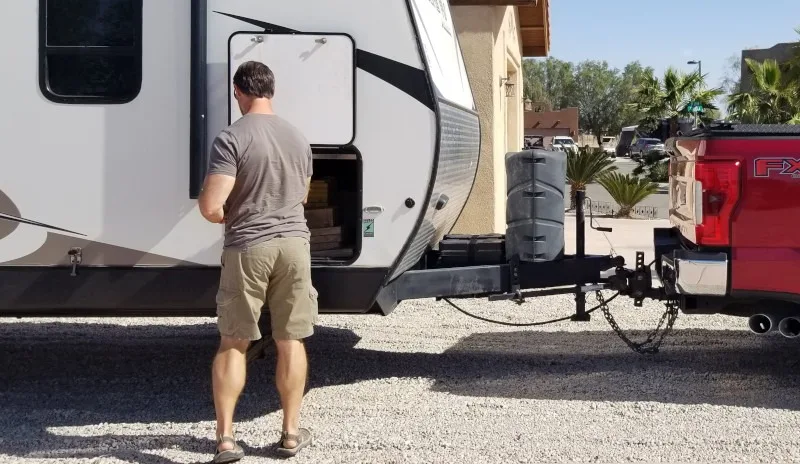
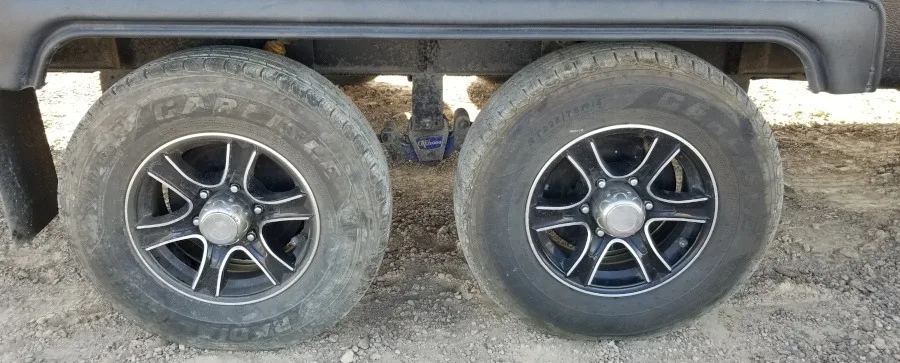
We learned that lesson the hard way!
All of this will become second nature for any RV owner who travels frequently.
RV Moving Tips
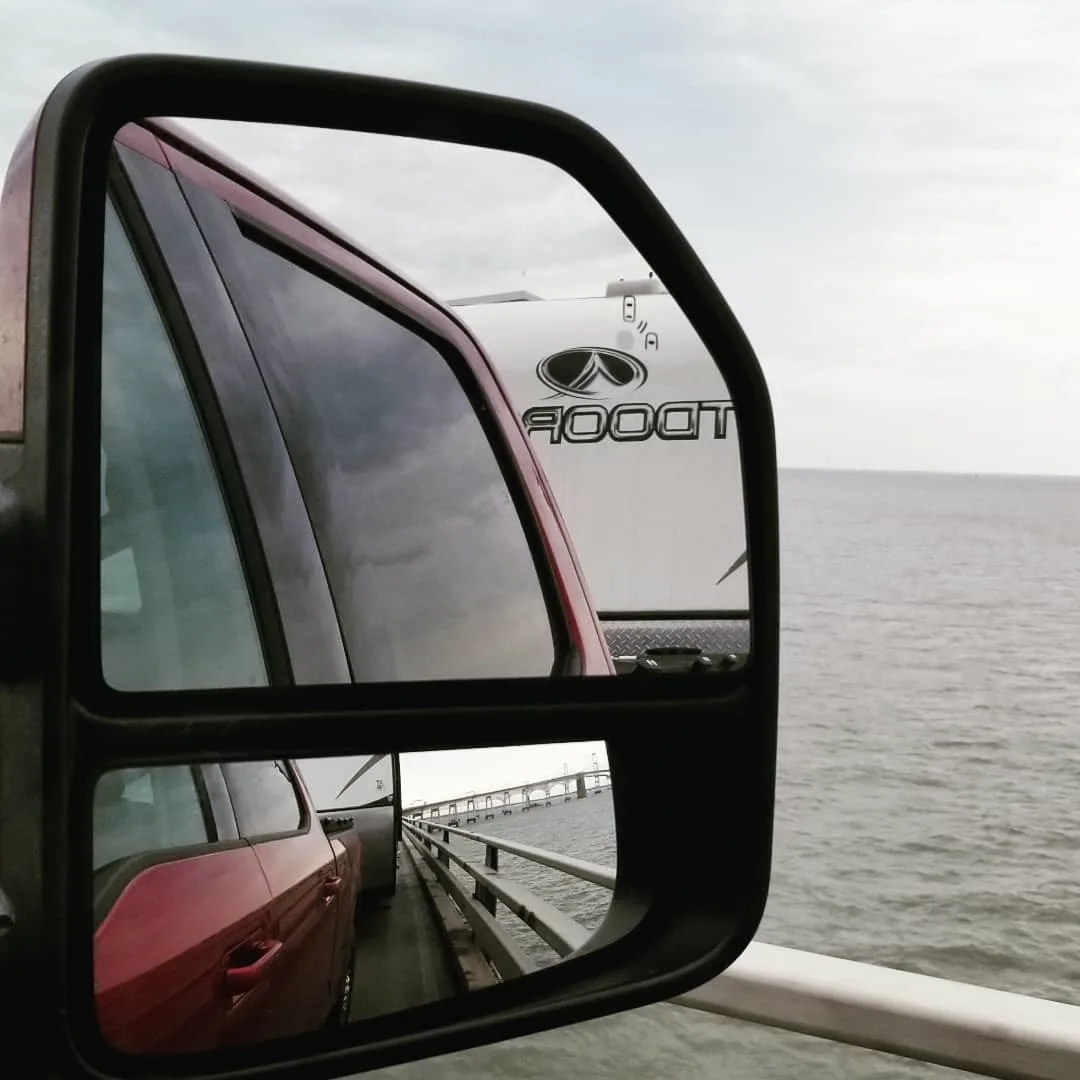
These tips are not just for moving day when boondocking fulltime. They apply to all types of RV owners.
-
Travel Less Than 300 Miles
-
Try To Arrive To Your Destination By 3PM
-
Check The Weather Along The Route
-
Use Multiple GPS Systems
-
Check Your Departure Time Against Arrival Time On Beltways/Busy Highways
-
Allow More Time For Travel Than You Think You Need
-
Begin Looking For Fuel At Half Tank
-
To Save Money, Use Fuel Stations Further From The Interstate
-
Plan On Stopping Along The Way to Enjoy A Meal Using Your Kitchen
-
Plan Your Grocery Trips Along Your Route On Moving Day
-
Dump Your Tanks And Fill Fresh Water At A Dump Station Along Your Route
-
Make Sure Your Kids Are Entertained
-
Empty Your Bladder Shortly Before Arriving To Your Camp Site
-
Have A Snack Shortly Before Arriving
When we first began, it was all about devouring miles and doing big moves.
Yeah, it was draining!
We learned quickly to shorten the distance and take our time. Besides, what’s the rush?
This is easy if you’re not pushing too many miles. Why arrive early?
It gives you time to set up before dinner and time to make dinner.
If your plan A or plan B for a boondocking location doesn’t pan out, you still have time to move onto plan C.
Also, arriving earlier opens up more options for boondocking spots.
We do this the day before and will abstain from moving if the weather is uncooperative.
What’s uncooperative? Strong storms, high wind or heavy rain. All of which are too dangerous to risk moving when you don’t have to.
This may not be possible if you’re in a campground rather than boondocking. Another great benefit of boondocking!
We like to use the Windy App along our route and adjust our route based on wind gusts.
There are times when the truck’s GPS disagrees with our phone’s GPS on our camper moving day.
By having two systems routing us simultaneously, we can evaluate the options in real time as we make our way.
The satellite feature on Google maps is also helpful to check surrounding infrastructure.
Better yet, the topographic feature on Google Maps allows us to check the elevation gain around potential boondocking sites.
If it’s too steep and we’re not making it into our potential boondocking site.
If you know you’re going to hit a beltway, avoid arriving there during any phase of rush hour.
It only took us a few mistakes to learn our lesson.
Not Sure What You Need For Your RV?
We generally averaged 45-50 MPH on any moving day.
This is because we stopped briefly every hour to stretch, use the rest room, dump our tanks, fill water and patron a grocery store.
Knowing and accepting this in advance is a great way to diminish any anxiety.
There are a lot of times when we would go a really long way between fuel stations that we could fit in. Filling at half tank offers a buffer.
It offers peace of mind and prevents any unnecessary anxiety.
It also allows you an opportunity to be thrifty if you’re using an app like Gas Buddy.
“Hey, 30 miles ahead, it’s fifty cents cheaper and the satellite shows we can fit.” That always sounds nice when we hit half tank!
Technology makes this easy. Some of the fuel stations require a little more skill with a large vehicle, but it can really be worth the effort.
Most fuel stations next to the interstate charge more than those one or two miles off the interstate.
A lot of the time, the smaller fuel station’s prices are better than big-name fuel discount memberships.
No doubt, you already possess this knowledge.
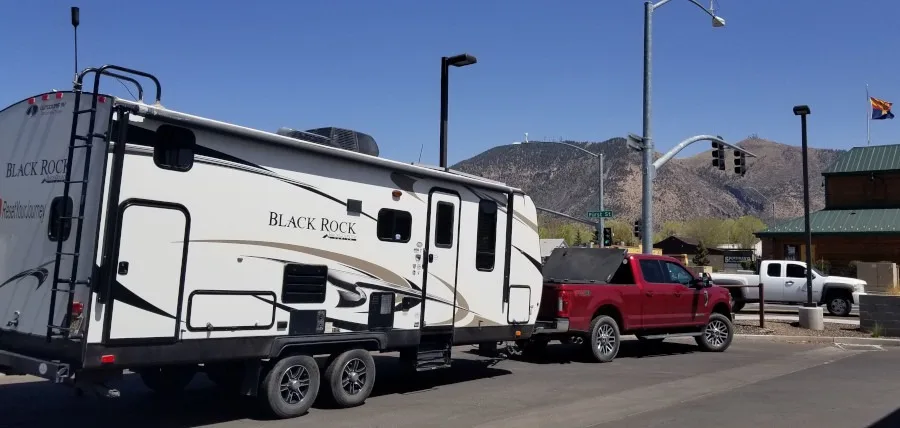
Most of you have a full kitchen with you. Make your lunch fresh and enjoy the break.
We like to hit a Walmart along the route and top off our groceries.
This is also when we usually eat lunch. It allows us to throw our trash away and use Walmart’s bathrooms.
Refreshed, recharged and ready to roll!
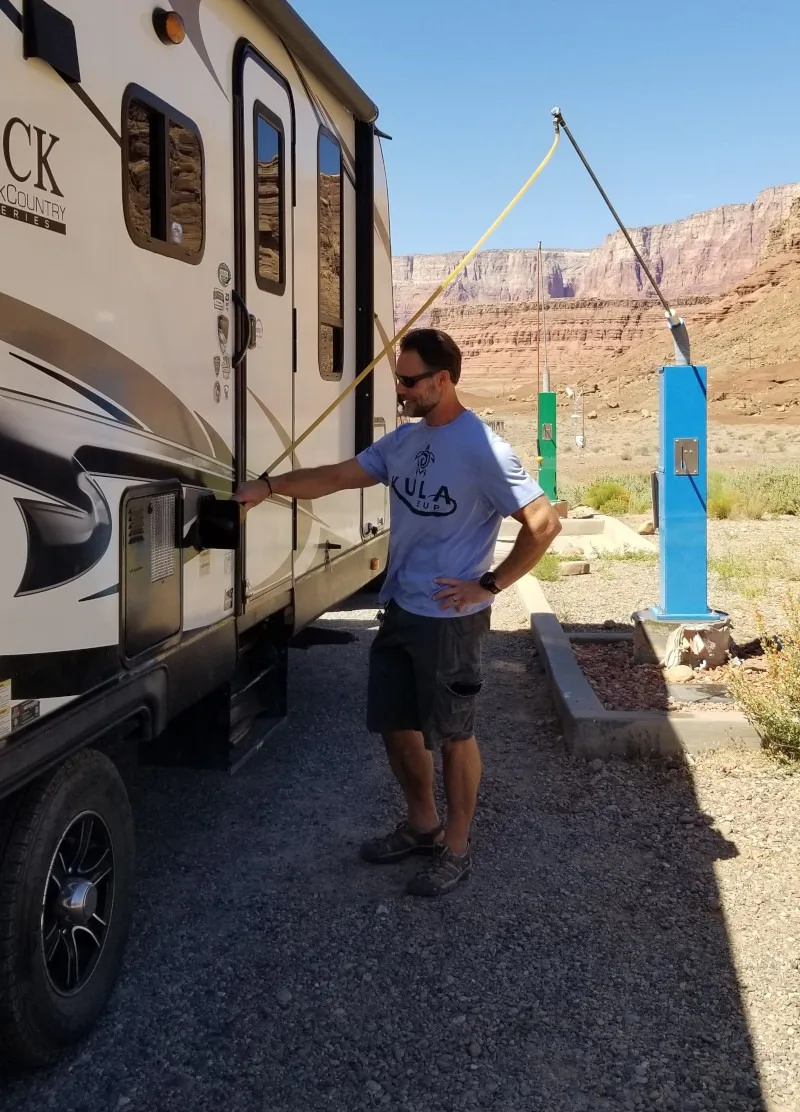
We always plot several options to dump the tanks and acquire potable water along the way.
We hit the first one on our list. That way, if it’s not suitable, we have more options along the route.
I’m not going to lie, RV moving day is Minecraft day for the boys.
The hotspot travels in the truck with us, so then can play online.
Sure, conversation, reading a book or looking out the window is nice, but admit it, we would have loved to have the tablet option when we were kids!
About a half hour before arriving to our plan A destination, we always pulled over to pee.
It makes looking for the perfect boondocking spot upon arrival A LOT more enjoyable.
If you’re staying in an RV park, it makes maneuvering your rig into the spot easier.
This is the same principal as above. Looking for a boondocking location when you’re “hangry” is no fun.
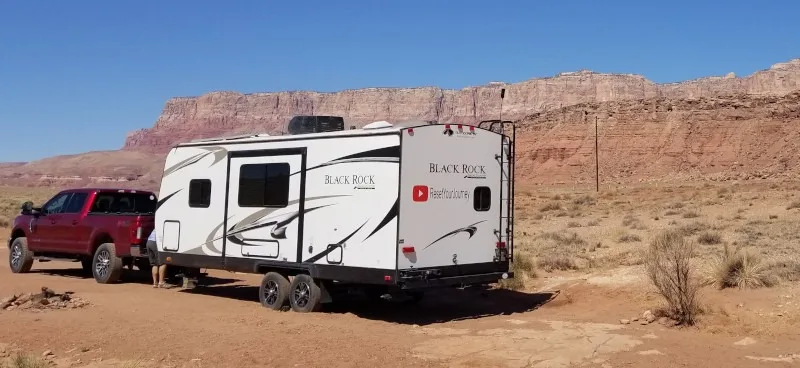
Wrapping Up Moving While Fulltime RV Living
Some of these tips are obvious. But it takes some “seasoning” and experience to work all of these camper moving day tips into your plan.
It’s important to follow the necessary steps in this RV departure checklist to keep you and everyone else on the road safe.
It can really make the difference between a fun road trip and a miserable ride.
Check out our RV setup checklist: Travel Trailer Setup Checklist For Camping (Free For Phone)
How do you make your RV moving day go smoothly?
We appreciate any help we can get to bring you great content. Donate or buy us a coffee on our Ko-Fi site.

